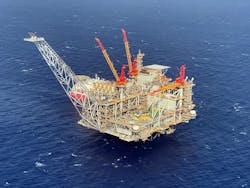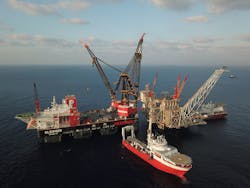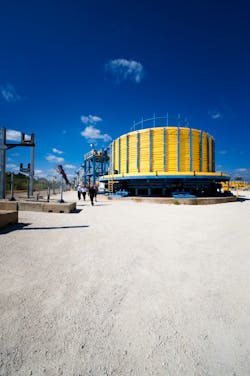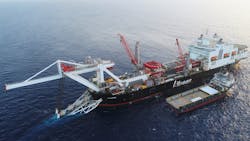Deepwater Leviathan gas project secures Israel’s energy needs
Long-distance tieback to nearshore platform
Leviathan is Israel’s third offshore natural gas field development and the most ambitious to date for operator Noble Energy. Discovered in 2010 by Noble and partners Delek Drilling and Ratio Oil Exploration, Leviathan, as its name suggests, is a deepwater giant. The field contains an estimated 35 tcf in-place and 22 tcf recoverable. The first phase of Leviathan development consists of four subsea production wells tied back to a shallow water production platform where gas will be processed to meet pipeline specifications. Its initial 1.2 bcf/d throughput will more than double the production capacity connected to the Israeli grid, meeting Israel’s growing domestic demand while enabling exports to neighboring countries and global gas markets. And the topsides installation completed last September, was the first commercial test of Sleipnir, the world’s newest and largest semisubmersible heavy lift crane vessel.
The field is situated 129 km (80 mi) west of Haifa in the gas-prolific Levantine basin - other nearby discoveries include the Noble-operated Tamar; its Aphrodite field offshore southeast Cyprus; and Eni’s Zohr off northeast Egypt. Transocean’s semisub Sedco Express drilled the Leviathan-1 discovery well in November 2010 in 1,645 m (5,397 ft) of water in what was then the Rachel license, finding gas in a similar geological/depositional setting to Tamar in various sub-salt Miocene intervals.
Over the next two years Noble hired two further semis, the Noble Homer Ferrington and the Pride North America, for deepening of Leviathan-1 and subsequent appraisal drilling, with the program resuming in 2017 using the drillship Atwood Advantage. The results revealed a 325-sq km (125-sq mi) accumulation extending across the 1/14 Leviathan North and 1/14 Leviathan South leases, in water depths ranging from 1,600-1,750 m (5,249-5,741 ft), with recoverable gas resources of 22 tcf and 40 MMbbl of associated condensate.
In mid-2016 Noble awarded front-end engineering design (FEED) studies to Wood and Cronus Technology in Houston for respectively the platform and the subsea pipeline system. In early 2016 Israel’s Ministry of National Infrastructures, Energy and Water Resources approved Noble’s plan for a phased development with the partners committing to the project at the end of 2016. [FID was February 2017]. Phase 1, with an estimated price tag of $3.75 billion, would entail drilling four high-output subsea wells in 5,500 ft water depth exporting production through two 118-km flowlines to a fixed platform 10 km (6.2 mi) from the Israeli mainland in 86 m (282 ft) of water. From there, the processed gas and stabilized condensate would flow through a northern entry pipeline to an onshore connection to the Israel Natural Gas Lines (INGL) national gas transmission system.
According to George Karker, Project Engineering Manager at Wood in Houston, at the start of 2016 Noble had established the key development and execution requirements and had already matured preliminary concepts for the facility. “This data was used to solicit competitive bids from contractors that were pre-qualified to perform the work,” he explained. “Wood interacted with Noble through the tender process and was ultimately awarded the FEED, detail design and procurement of the topsides and jacket in June 2016.”
Wood and the designated platform fabricator Kiewit Offshore Services had previously worked together for Noble on the Mari-B and Tamar field platforms, and Heerema Marine Contractors, the selected platform installer for Leviathan, had also collaborated with the trio previously. “The successful execution of previous projects and the incorporation of lessons learned from those efforts played a major role in developing execution plans and contracting strategies,” Karker said. “Over the course of more than three years in FEED, detailed design and follow-on engineering for Leviathan, Wood, Kiewit and Heerema participated in value improvement programs and ongoing lessons-learned exercises. Kiewit provided valuable input to the topsides design from its previous experiences working with Wood design documents for Tamar and other projects.
“Another key factor was Wood’s ability to engage engineers and designers that had experience with the success of the Tamar project. Those individuals had established working relationships with key members of Noble Energy’s team and fully understand the company’s expectations, specifications, requirements and ways of working. Lastly, Wood’s project execution systems and processes that were proven on Tamar were also implemented for Leviathan. The fact that these were known by Noble and Kiewit helped all parties to successfully work through approvals and interfaces to complete the detailed engineering design.”
Wood’s full scope of work for Leviathan Phase 1 included procurement of all components for the platform, excluding bulk materials; engineering support for fabrication, which started at Kiewit’s yard in Ingleside, Texas, in March 2017; providing follow-on engineering support to complete fabrication and sail away; start-up and commissioning support in the run-up to first gas, targeted for late-2019; and detail engineering and design of the onshore receiving terminal at Hagit. Wood’s effort was provided out of their Houston offices.
The Leviathan platform comprises a conventional fixed steel jacket, 98 m (321 ft) tall and weighing 15,500 metric tons (17,085 tons), supporting a 47-m (154-ft) high topsides with a total weight of 30,000 metric tons (33,069 tons). The topsides decks, which are 102 m (334 ft) long and 80 m (262 ft) wide, comprise five major components: a Domestic Supply Module (DSM); a Liquids Supply Module (LSM); an MEG Reclamation Unit (MRU); a 100 persons living quarters; and a flare boom. Also included are all utilities required to operate the platform without the need of outside assistance, such as power generation, water desalination and waste treatment. A future-phase 9,700-metric ton (10,692-ton) Regional Export Module (REM) was also factored into the design of the topsides and jacket.
As the design and engineering progressed, Noble did not ask for a weight reduction from Wood’s initial estimate, Karker said. “The primary consideration during FEED was to develop a ‘not to exceed operating payload’ for the jacket and pile design. The other primary issue was prediction of the DSM lift weight with an initial plan to lift this in two sections using Heerema’s Thialf vessel. However, it became clear that this was going to be a challenge so Noble and Heerema decided to use Sleipnir, with its heavier lift capacity, to install the DSM in one section. Then the focus was on making sure that the DSM did not exceed Sleipnir’s capacity.” At the same time, various options were drawn up for a lighter-lift scenario until near the end of fabrication as a mitigating contingency for both the DSM and the LSM in case they proved too heavy for Sleipnir in its first offshore work-out. According to Heerema’s Transportation and Installation Director Michel Hendriks, there was also a ‘vessel decision date’ by which Noble could select Thialf for the topsides installation as a fallback in case it became clear that Sleipnir – which was under construction in Singapore - would not be ready in time.
Heerema modeled the jacket installation and the topsides lift at its new simulation center in Leiden, the Netherlands. Noble was involved in the topsides simulations, Hendriks said. Wood, meanwhile, was responsible for estimating and continuously updating a weight control report as the topsides design evolved. This, Karker explained, allowed the company to accurately predict weight and the Center of Gravity (COG) for the offshore lifts, with Heerema advising on Sleipnir’s allowable lift capacity for different COGs. Wood deployed various software tools for its simulations for the FEED and detail design, the main ones being PDMS (facility modeling, material handling, functionality, compliance and operability); HSYS (process simulations); and SACS (structural analysis).
Early in 2018 Noble contracted Schlumberger to engineer and supply the 2,500-metric ton (2,756-ton) single-lift MEG Reclamation Unit (MRU), thought to be the largest the company has ever delivered. The module, fabricated under a sub-contract by Dyna-Mac in Singapore, is designed for pre-treatment, salt removal and regeneration of large volumes of monoethylene glycol (MEG) that are reinjected through the long-distance subsea flowline system for hydrate inhibition. “The hydrate mitigation design is similar to that at Tamar,” said Brian Hogan, Noble’s Project Manager for Leviathan. “Dedicated MEG pipelines run from the platform to a subsea distribution assembly from where the MEG travels via an in-field umbilical to the subsea trees.” Karker added: “The MEG reclamation unit is relatively uncommon worldwide, and there are very few offshore.”
Construction of the topsides was completed within 26 months, with 2,200 personnel working on it at peak. Companies from over 24 countries worldwide manufactured parts for the platform, with more than 40 Israeli companies involved in the platform execution. “An approach was developed to engage Israeli firms to review and ensure proper codes and standards were incorporated into the overall design,” Karker said.
Leviathan’s offshore gas gathering system would comprise 14-in. infield flowlines from each well to a subsea production manifold from where the gas would head through dual 18-in. flowlines to the platform. The system was also designed to accommodate tie-in to a future regional export system through an additional 14-in. infield flowline and a 20-in. gathering flowline to the platform. The system was engineered to also accommodate further development of the field by allowing future wells to be tied-in at the pipeline end terminations (PLETs) or manifold.
Processed gas departs the platform through a 32-in. pipeline to the shore for domestic sales, with a separate 6-in. line transporting produced condensate to the onshore pipeline via a 56-in. direct conduit pipe casing. Cronus Technology’s FEED duties included designing the layout of the manifold and drill centers; pipeline route selection including wall thickness and lateral buckling/expansion studies; and design of the 6-in. MEG lines from the platform to the manifold.
Between March and December 2018 the Valaris ultra-deepwater drillship DS-7 batch-drilled and completed the four Phase 1 subsea production wells, each designed for peak flow rates of 300 MMcf/d. OneSubsea engineered and supplied the 10,000-psi (689-bar) horizontal production trees, tree-mounted and off-tree controls, and topsides controls.
TechnipFMC had overall responsibility for installing the entire SURF system, including the subsea production manifolds connecting the wells and the subsea distribution assembly (both supplied by Houston-based Trendsetter Engineering), and flying leads, in addition to diving and pre-commissioning of the system. However, the company subcontracted some of the T&I work, delegating Rotterdam-based Jumbo Offshore to transport the 410-t subsea production manifold from the US Gulf Coast to the Leviathan seafloor location in 1,645 m (5,397 ft) of water. In addition, Jumbo installed various subsea isolation valves and valve skids close to the platform in 86 m (282 ft) water depth.
Aker Solutions started on the design of the control umbilicals in summer 2016. The company manufactured the entire consignment, totaling 150 km (93 mi), at its plant in Mobile, Alabama, with TechnipFMC using the Skandi Africa and Deep Blue to install the full package in May 2019. The umbilicals incorporate hydraulics, chemical delivery, low-voltage power and fiber optics. Sandvik supplied the SAF 2507 super-duplex stainless steel tubes for the injection and hydraulic fluids.
Allseas was responsible for installation of the flowline system and the export pipeline from the platform to the shore. The program started in 1Q 2018 when Audacia started the deepwater section of the campaign, comprising the 20-km (12.4-mi), 14-in. in-field flowlines and the two 118-km (73.3-mi), 18-in. gathering lines from 85 m water depth (close to the location of the platform) out to the subsea production manifolds in 1,750 m (5,741 ft) of water. The next step was to pull-in the 32-in. trunkline (with dual 6-in. piggyback lines strapped on top) through the 56-in. HDD casing, followed by placement of the trunkline through a 9-km (5.6-mi) long trench.
Also part of Allseas’ scope were the pre-lay surveys and crossing preparation works. These involved:
• Installing 44 crossing structures for the upstream pipelay in water depths ranging from 90-1,750 m (295-5,741 ft)
• Drilling a 1.2-km (0.75-mi) HDD shore crossing and installing a steel carrier pipe with an OD of 56-in. and wall thickness of 22 mm – for the 32-in. pipeline landfall on the Israeli coast.
During the summer of 2018, Allseas’ Lorelay partly installed the two 118-km, 6-in. MEG pipelines from 85 to 1,700 m water depth. In January 2019, Audacia returned to lay the remaining 57 km (35 mi) of the deepest sections of both MEG lines not covered by Lorelay. Finally, Audacia installed 13 PLETs with a total lift weight of more than 1,300 metric tons (1,433 tons), in a water depth of 1,650 m (5,413 ft).
For Wood the main design considerations for installation of the 98-m (321-ft) tall, 15,500-metric ton jacket were the conditions for load-out, transport, launch and in-place, Karker explained. “The most critical case was ‘in-place’ combined with metocean conditions. The weight of the topsides would make gravity loading a dominant condition. Launching was to be conventional, although it would need to be performed in slightly deeper water than at the actual offshore site. The soil conditions at Leviathan are relatively normal with the majority of the capacity from clay skin friction. There is a hard, rocky, beach-type layer at about 30 m (98.4 ft) penetration which during the jacket installation caused the piling to stop there prior to driving. But this was predicted, and the operation went according to plan.”
In January 2019 the jacket arrived at the field location onboard a 180-m (590-ft) long transportation barge, following a 28-day, 11,500-km (7,146-mi) voyage across the Atlantic. According to Heerema’s Hendriks, “the main challenge for the jacket tow was the anticipated 11-m (36-ft) significant wave height during the winter time. The extreme design wave height called for a robust seafastening design during the tow with a particular focus on safe and efficient cutting access. The rigging lashings were specially engineered to be virtually indestructible during transport while being relatively easy to break prior to installation without the risk of falling into the sea. Further the towing subcontractor was closely involved during all phases of the project including hazard identification and risk management, detailed procedural development and daily teleconferences for the duration of the tow.
“Safe transfer of personnel to the cargo barges was a priority. Heerema used its ‘T-bag’ (tug-barge access gangway) system to provide access to the launch barge throughout all stages of the jacket launch.
“The jacket was designed with vertical legs and 16 skirt piles, which required additional pile guides along the jacket legs to mitigate the effects of potentially excessive pile sway during the installation. In turn, the pile guides required the use of followers in order to drive the piles to penetration.”
In this part of the eastern Mediterranean, the swell profile can be quite rough, Hendriks said, but with shorter-period waves than, for instance, offshore Brazil or West Africa. “The area can also be prone to high currents over the full height of the water depth, these high currents were experienced during jacket upending and setdown. But during the preparations Heerema had devised solutions to the currents and consequently Heerema was able to achieve installation of the jacket within specifications, in a total of 19 days, on schedule.” Installing the jacket this early in the year also allowed the subsea system to be interconnected off critical path ahead of the topsides installation eight months later, said George Hatfield, Noble’s VP of Major Projects.
“Heerema’s modeling of the topsides lift at its simulation center in Leiden allowed Sleipnir’s offshore crew to familiarize themselves with the vessel’s behavior during lift-off and set-down of the topsides,” Hendriks said. “Noble was very actively involved in these Phase 2 simulations and this created a good team understanding prior to heading offshore. Guide and bumper systems were tested and verified throughout the design by simulations. This led to optimization of the locations and sizes of guides as well as minimizing the offshore construction of infill structures due to accurate clash checks.”
Last June, the newly delivered, LNG-powered construction vessel completed sea trials and load tests of its two 10,000-metric ton (11,023-ton) revolving cranes, with the dynamic positioning system performance exceeding expectations. The vessel subsequently sailed from southern Spain to the Leviathan offshore location, while at the same time three barges were crossing the Atlantic carrying the topsides modules. In September, Sleipnir performed the installations successfully, the program including a world-record single module lift (for a semisubmersible crane vessel) of 15,300 metric tons (16,865 tons).
“The only weather-related issue during this program was a delay in installing one of the smaller modules due to the barge natural frequency aligning with the sea state,” Hendriks said. “Sleipnir was able to operate throughout all weather conditions experienced. The full topsides installation was completed in 12 days, well ahead of the planned schedule. The fact that the program took place during the summer season helped, but the schedule improvement was mainly the result of Sleipnir’s outstanding performance on its maiden offshore assignment, setting a new world record lift without any mechanical or operational delays.”
Hookup and commissioning operations could now get under way, with a tight schedule in the run-up to the targeted start-up in December 2019. “As with any of our designs,” Wood’s Karker explained, “Wood endeavors to minimize offshore hookup and commissioning for obvious reasons. Noble Energy had clear expectations and a defined program schedule for installation being completed and reaching first gas. To meet these demands our design set forth defined and dimensionally controllable module interface zones. The location of electrical buildings and overall process systems considered minimizing cable and piping runs across these zones. Engineering worked with the hookup contractor team that Noble had engaged in order to establish staging areas for the structural steel, cable reels and piping needed for the integration. Several modeling simulation sessions took place at the end of detail engineering that simulated how structural members and piping spools needed to be rigged and set in place to minimize time required for installation.”
Sticking to the schedule is a key objective for Noble and its partners as they seek to fulfil contracted gas supplies not just from Leviathan but also from Tamar. The contracts are not solely with Israeli end-users: agreements are also in place to sell 3 tcf of gas from the two fields to Dolphinus in Egypt. Late last year the partners acquired a 39% stake in Eastern Mediterranean Gas Company, which owns and operates the 90-km (56-mi) EMG pipeline that connects the Israeli pipeline network to the Egyptian pipeline network. The pipeline will be used to export gas via the Egyptian domestic pipeline system to both the domestic market and for international export through existing LNG infrastructure. These developments are key elements of Egypt’s planned Eastern Mediterranean gas hub.
Noble also has an option to transport more gas via an agreement with the owner and operator of the Aqaba - El Arish pipeline. Wood’s base design for the platform topsides has sales gas going to only one location, Karker said, and a typical metering package to accommodate a future export scenario. However, provisions have been made for the addition of future metering skids capable of directing sales gas to multiple locations.
An alternative option for increasing production from the Leviathan reservoir could be floating LNG. The partners have held discussions with Exmar and Golar LNG on studies concerning a potential FLNG facility that could convert up to 4-7 bcm/yr to LNG. According to Noble’s George Hatfield, the final investment decision on Leviathan Phase 2 will be driven by future natural gas sales demand. “The platform and subsea architecture are designed for an expansion of throughput capacity from 1.2 to 2.1 bcf/d,” he pointed out. •
About the Author
Jeremy Beckman
Editor, Europe
Jeremy Beckman has been Editor Europe, Offshore since 1992. Prior to joining Offshore he was a freelance journalist for eight years, working for a variety of electronics, computing and scientific journals in the UK. He regularly writes news columns on trends and events both in the NW Europe offshore region and globally. He also writes features on developments and technology in exploration and production.





